Xuedong Huang
ComSL: A Composite Speech-Language Model for End-to-End Speech-to-Text Translation
May 24, 2023



Abstract:Joint speech-language training is challenging due to the large demand for training data and GPU consumption, as well as the modality gap between speech and language. We present ComSL, a speech-language model built atop a composite architecture of public pretrained speech-only and language-only models and optimized data-efficiently for spoken language tasks. Particularly, we propose to incorporate cross-modality learning into transfer learning and conduct them simultaneously for downstream tasks in a multi-task learning manner. Our approach has demonstrated effectiveness in end-to-end speech-to-text translation tasks, achieving a new state-of-the-art average BLEU score of 31.5 on the multilingual speech to English text translation task for 21 languages, as measured on the public CoVoST2 evaluation set.
i-Code Studio: A Configurable and Composable Framework for Integrative AI
May 23, 2023



Abstract:Artificial General Intelligence (AGI) requires comprehensive understanding and generation capabilities for a variety of tasks spanning different modalities and functionalities. Integrative AI is one important direction to approach AGI, through combining multiple models to tackle complex multimodal tasks. However, there is a lack of a flexible and composable platform to facilitate efficient and effective model composition and coordination. In this paper, we propose the i-Code Studio, a configurable and composable framework for Integrative AI. The i-Code Studio orchestrates multiple pre-trained models in a finetuning-free fashion to conduct complex multimodal tasks. Instead of simple model composition, the i-Code Studio provides an integrative, flexible, and composable setting for developers to quickly and easily compose cutting-edge services and technologies tailored to their specific requirements. The i-Code Studio achieves impressive results on a variety of zero-shot multimodal tasks, such as video-to-text retrieval, speech-to-speech translation, and visual question answering. We also demonstrate how to quickly build a multimodal agent based on the i-Code Studio that can communicate and personalize for users.
i-Code V2: An Autoregressive Generation Framework over Vision, Language, and Speech Data
May 21, 2023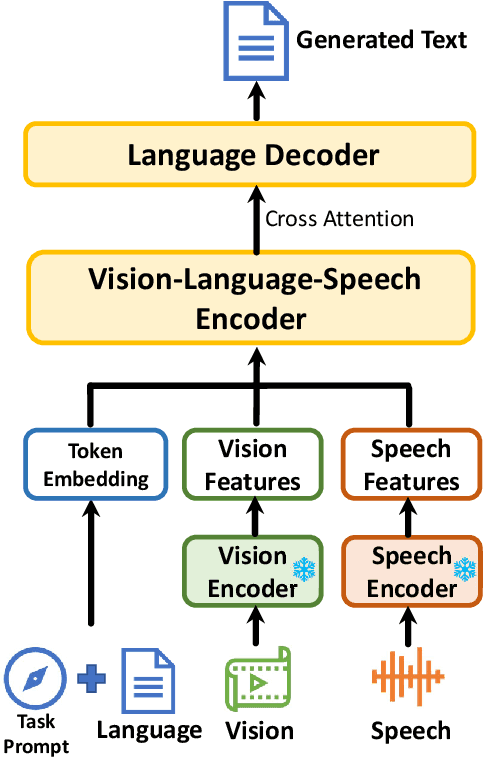
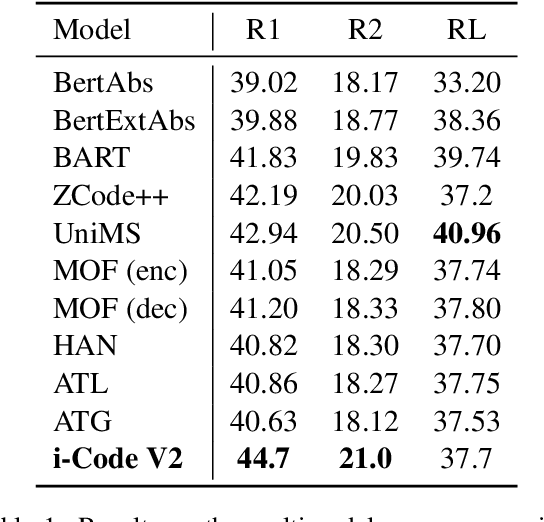
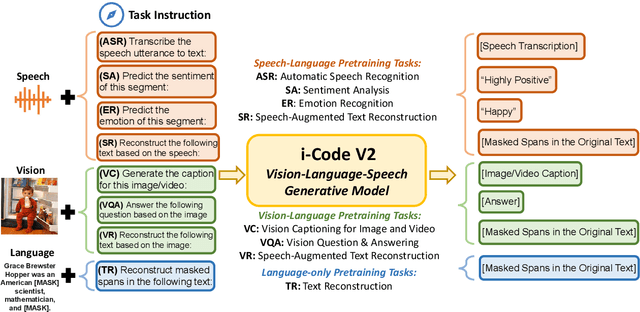
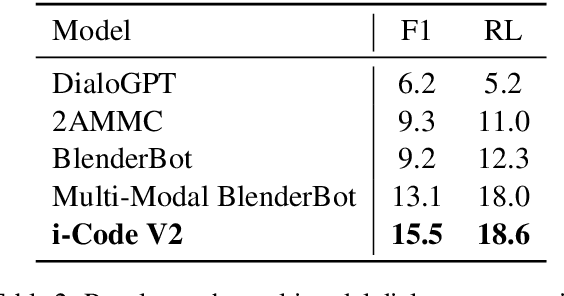
Abstract:The convergence of text, visual, and audio data is a key step towards human-like artificial intelligence, however the current Vision-Language-Speech landscape is dominated by encoder-only models which lack generative abilities. We propose closing this gap with i-Code V2, the first model capable of generating natural language from any combination of Vision, Language, and Speech data. i-Code V2 is an integrative system that leverages state-of-the-art single-modality encoders, combining their outputs with a new modality-fusing encoder in order to flexibly project combinations of modalities into a shared representational space. Next, language tokens are generated from these representations via an autoregressive decoder. The whole framework is pretrained end-to-end on a large collection of dual- and single-modality datasets using a novel text completion objective that can be generalized across arbitrary combinations of modalities. i-Code V2 matches or outperforms state-of-the-art single- and dual-modality baselines on 7 multimodal tasks, demonstrating the power of generative multimodal pretraining across a diversity of tasks and signals.
Z-Code++: A Pre-trained Language Model Optimized for Abstractive Summarization
Aug 21, 2022



Abstract:This paper presents Z-Code++, a new pre-trained language model optimized for abstractive text summarization. The model extends the state of the art encoder-decoder model using three techniques. First, we use a two-phase pre-training process to improve model's performance on low-resource summarization tasks. The model is first pre-trained using text corpora for language understanding, and then is continually pre-trained on summarization corpora for grounded text generation. Second, we replace self-attention layers in the encoder with disentangled attention layers, where each word is represented using two vectors that encode its content and position, respectively. Third, we use fusion-in-encoder, a simple yet effective method of encoding long sequences in a hierarchical manner. Z-Code++ creates new state of the art on 9 out of 13 text summarization tasks across 5 languages. Our model is parameter-efficient in that it outperforms the 600x larger PaLM-540B on XSum, and the finetuned 200x larger GPT3-175B on SAMSum. In zero-shot and few-shot settings, our model substantially outperforms the competing models.
i-Code: An Integrative and Composable Multimodal Learning Framework
May 05, 2022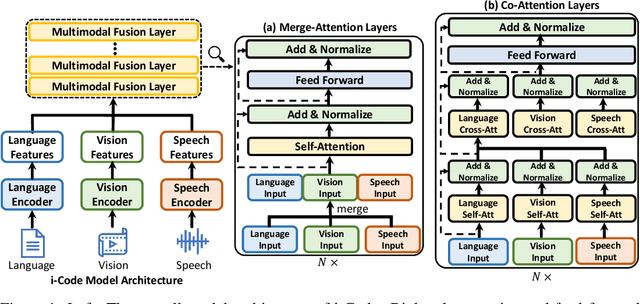
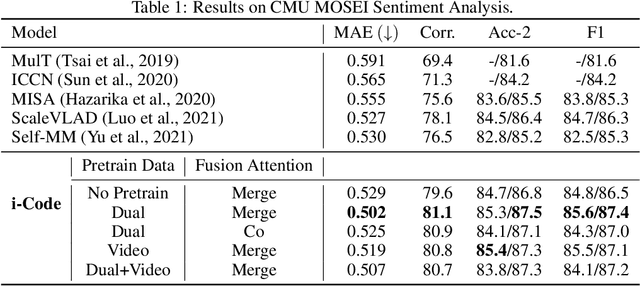
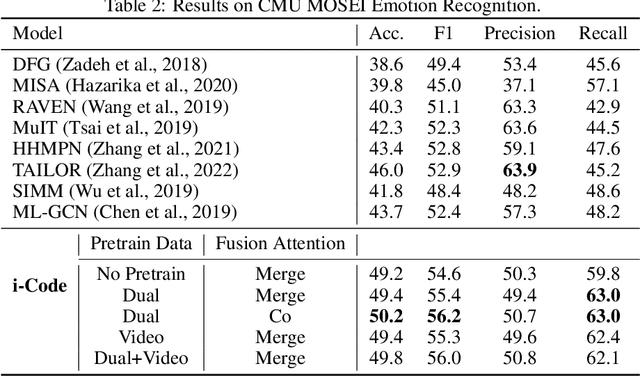

Abstract:Human intelligence is multimodal; we integrate visual, linguistic, and acoustic signals to maintain a holistic worldview. Most current pretraining methods, however, are limited to one or two modalities. We present i-Code, a self-supervised pretraining framework where users may flexibly combine the modalities of vision, speech, and language into unified and general-purpose vector representations. In this framework, data from each modality are first given to pretrained single-modality encoders. The encoder outputs are then integrated with a multimodal fusion network, which uses novel attention mechanisms and other architectural innovations to effectively combine information from the different modalities. The entire system is pretrained end-to-end with new objectives including masked modality unit modeling and cross-modality contrastive learning. Unlike previous research using only video for pretraining, the i-Code framework can dynamically process single, dual, and triple-modality data during training and inference, flexibly projecting different combinations of modalities into a single representation space. Experimental results demonstrate how i-Code can outperform state-of-the-art techniques on five video understanding tasks and the GLUE NLP benchmark, improving by as much as 11% and demonstrating the power of integrative multimodal pretraining.
Human Parity on CommonsenseQA: Augmenting Self-Attention with External Attention
Dec 14, 2021



Abstract:Most of today's AI systems focus on using self-attention mechanisms and transformer architectures on large amounts of diverse data to achieve impressive performance gains. In this paper, we propose to augment the transformer architecture with an external attention mechanism to bring external knowledge and context to bear. By integrating external information into the prediction process, we hope to reduce the need for ever-larger models and increase the democratization of AI systems. We find that the proposed external attention mechanism can significantly improve the performance of existing AI systems, allowing practitioners to easily customize foundation AI models to many diverse downstream applications. In particular, we focus on the task of Commonsense Reasoning, demonstrating that the proposed external attention mechanism can augment existing transformer models and significantly improve the model's reasoning capabilities. The proposed system, Knowledgeable External Attention for commonsense Reasoning (KEAR), reaches human parity on the open CommonsenseQA research benchmark with an accuracy of 89.4\% in comparison to the human accuracy of 88.9\%.
Florence: A New Foundation Model for Computer Vision
Nov 22, 2021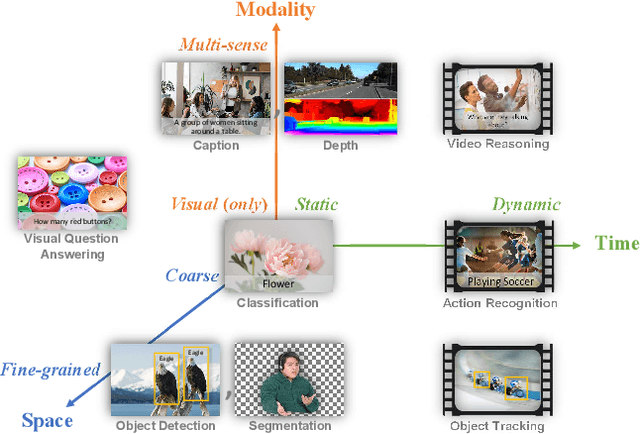

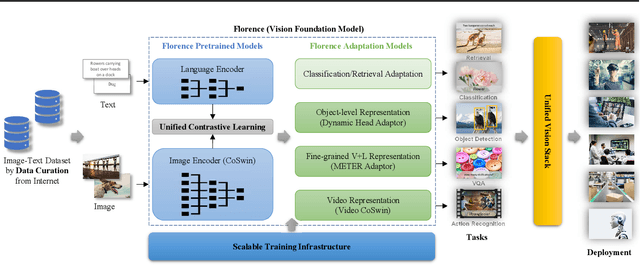
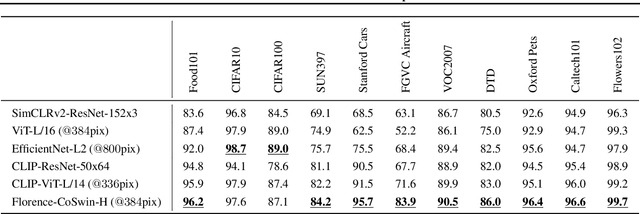
Abstract:Automated visual understanding of our diverse and open world demands computer vision models to generalize well with minimal customization for specific tasks, similar to human vision. Computer vision foundation models, which are trained on diverse, large-scale dataset and can be adapted to a wide range of downstream tasks, are critical for this mission to solve real-world computer vision applications. While existing vision foundation models such as CLIP, ALIGN, and Wu Dao 2.0 focus mainly on mapping images and textual representations to a cross-modal shared representation, we introduce a new computer vision foundation model, Florence, to expand the representations from coarse (scene) to fine (object), from static (images) to dynamic (videos), and from RGB to multiple modalities (caption, depth). By incorporating universal visual-language representations from Web-scale image-text data, our Florence model can be easily adapted for various computer vision tasks, such as classification, retrieval, object detection, VQA, image caption, video retrieval and action recognition. Moreover, Florence demonstrates outstanding performance in many types of transfer learning: fully sampled fine-tuning, linear probing, few-shot transfer and zero-shot transfer for novel images and objects. All of these properties are critical for our vision foundation model to serve general purpose vision tasks. Florence achieves new state-of-the-art results in majority of 44 representative benchmarks, e.g., ImageNet-1K zero-shot classification with top-1 accuracy of 83.74 and the top-5 accuracy of 97.18, 62.4 mAP on COCO fine tuning, 80.36 on VQA, and 87.8 on Kinetics-600.
One model to enhance them all: array geometry agnostic multi-channel personalized speech enhancement
Oct 20, 2021

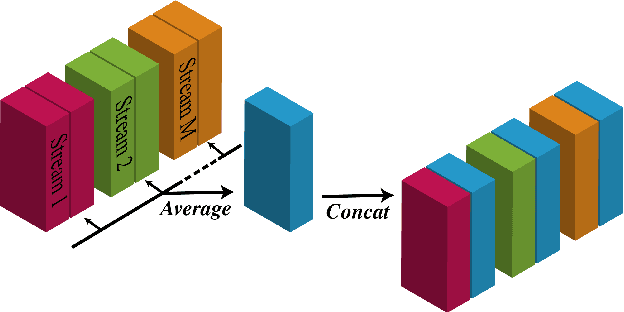

Abstract:With the recent surge of video conferencing tools usage, providing high-quality speech signals and accurate captions have become essential to conduct day-to-day business or connect with friends and families. Single-channel personalized speech enhancement (PSE) methods show promising results compared with the unconditional speech enhancement (SE) methods in these scenarios due to their ability to remove interfering speech in addition to the environmental noise. In this work, we leverage spatial information afforded by microphone arrays to improve such systems' performance further. We investigate the relative importance of speaker embeddings and spatial features. Moreover, we propose a new causal array-geometry-agnostic multi-channel PSE model, which can generate a high-quality enhanced signal from arbitrary microphone geometry. Experimental results show that the proposed geometry agnostic model outperforms the model trained on a specific microphone array geometry in both speech quality and automatic speech recognition accuracy. We also demonstrate the effectiveness of the proposed approach for unseen array geometries.
Personalized Speech Enhancement: New Models and Comprehensive Evaluation
Oct 18, 2021


Abstract:Personalized speech enhancement (PSE) models utilize additional cues, such as speaker embeddings like d-vectors, to remove background noise and interfering speech in real-time and thus improve the speech quality of online video conferencing systems for various acoustic scenarios. In this work, we propose two neural networks for PSE that achieve superior performance to the previously proposed VoiceFilter. In addition, we create test sets that capture a variety of scenarios that users can encounter during video conferencing. Furthermore, we propose a new metric to measure the target speaker over-suppression (TSOS) problem, which was not sufficiently investigated before despite its critical importance in deployment. Besides, we propose multi-task training with a speech recognition back-end. Our results show that the proposed models can yield better speech recognition accuracy, speech intelligibility, and perceptual quality than the baseline models, and the multi-task training can alleviate the TSOS issue in addition to improving the speech recognition accuracy.
UniSpeech: Unified Speech Representation Learning with Labeled and Unlabeled Data
Jan 19, 2021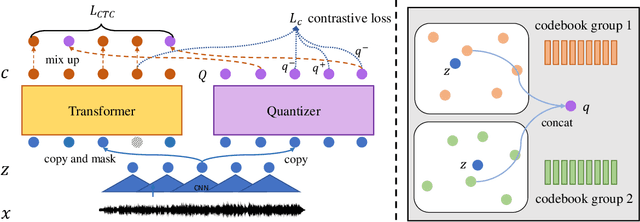



Abstract:In this paper, we propose a unified pre-training approach called UniSpeech to learn speech representations with both unlabeled and labeled data, in which supervised phonetic CTC learning and phonetically-aware contrastive self-supervised learning are conducted in a multi-task learning manner. The resultant representations can capture information more correlated with phonetic structures and improve the generalization across languages and domains. We evaluate the effectiveness of UniSpeech for cross-lingual representation learning on public CommonVoice corpus. The results show that UniSpeech outperforms self-supervised pretraining and supervised transfer learning for speech recognition by a maximum of 13.4% and 17.8% relative phone error rate reductions respectively (averaged over all testing languages). The transferability of UniSpeech is also demonstrated on a domain-shift speech recognition task, i.e., a relative word error rate reduction of 6% against the previous approach.
 Add to Chrome
Add to Chrome Add to Firefox
Add to Firefox Add to Edge
Add to Edge